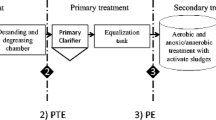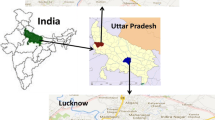Abstract
Thousands of tons of pharmaceuticals are introduced into the aqueous environment due to their incomplete elimination during treatment process in wastewater treatment plants (WWTPs) and water treatment plants (WTPs). The presence of pharmacologically active compounds in the environment is of a great interest because of their potential to cause negative effects. Furthermore, drugs can undergo different processes leading to the formation of new transformation products, which may be more toxic than the parent compound. In light of these concerns, within the research a new, rapid and sensitive analytical procedure for the determination of a wide range of pharmaceuticals from different classes using solid phase extraction (SPE) and high-performance liquid chromatography tandem mass spectrometry (HPLC-MS/MS) technique in different water samples was developed. This methodology was applied to investigate the occurrence, removal efficiency of 25 pharmaceuticals during wastewater and drinking water treatment, and seasonal variability in the amount of selected pharmaceuticals in WWTP and WTP over a year. The most often detected analytes in water samples were carbamazepine (100 % of samples) and ibuprofen (98 % of samples), concluding that they may be considered as pollution indicators of the aqueous environment in tested area. Highly polar compound, metformin, was determined at very high concentration level of up to 8100 ng/L in analyzed water samples. Drugs concentrations were much higher in winter season, especially for non-steroidal inflammatory drugs (NSAIDs) and caffeine, probably due to the inhibited degradation related to lower temperatures and limited sunlight. Carbamazepine was found to be the most resistant drug to environmental degradation and its concentrations were at similar levels during four seasons.


Similar content being viewed by others
References
Al-Odaini, N. A., Zakaria, M. P., Yaziz, M. I., & Surif, S. (2010). Multi-residue analytical method for human pharmaceuticals and synthetic hormones in river water and sewage effluents by solid-phase extraction and liquid chromatography–tandem mass spectrometry. Journal of Chromatography. A, 1217, 6791–6806.
Azzouz, A., & Ballesteros, E. (2013). Influence of seasonal climate differences on the pharmaceutical, hormone and personal care product removal efficiency of a drinking water treatment plant. Chemosph, 93, 2046–2054.
Boleda, M. R., Galceran, M. T., & Ventura, F. (2013). Validation and uncertainty estimation of a multiresidue method for pharmaceuticals in surface and treated waters by liquid chromatography–tandem mass spectrometry. Journal of Chromatography. A, 1286, 146–158.
Bueno, M. J. M., Agüera, A., Gómez, M. J., Hernando, M. D., García-Reyes, J. F., & Fernández-Alba, A. R. (2007). Application of liquid chromatography/quadrupole-linear ion trap mass spectrometry and time-of-flight mass spectrometry to the determination of pharmaceuticals and related contaminants in wastewater. Analytical Chemistry, 79, 9372–9384.
Bueno, M. J. M., Gomez, M. J., Herrera, S., Hernando, M. D., Aguera, A., & Fernandez-Alba, A. R. (2012). Occurrence and persistence of organic emerging contaminants and priority pollutants in five sewage treatment plants of Spain: two years pilot survey monitoring. Environmental Pollution, 164, 267–273.
Cahill, J. D., Furlong, E. T., Burkhardt, M. R., Kolpin, D., & Anderson, L. G. (2004). Determination of pharmaceutical compounds in surface- and ground-water samples by solid-phase extraction and high-performance liquid chromatography–electrospray ionization mass spectrometry. Journal of Chromatography. A, 1041, 171–180.
Castiglioni, S., Bagnati, R., Calamari, D., Fanelli, R. E., & Zuccato, J. C. A. 206(2005). A multiresidue analytical method using solid-phase extraction and high-pressure liquid chromatography tandem mass spectrometry to measure pharmaceuticals of different therapeutic classes in urban wastewaters. Journal of Chromatography. A, 1092, 206–215.
Cimetiere, N., Soutrel, I., Lemasle, M., Laplanche, A., & Crocq, A. (2013). Standard addition method for the determination of pharmaceutical residues in drinking water by SPE–LC–MS/MS. Environmental Technology, 34, 3031–3041.
Clara, M., Strenn, B., & Kreuzinger, N. (2004). Carbamazepine as a possible anthropogenic marker in the aquatic environment: investigations on the behaviour of carbamazepine in wastewater treatment and during groundwater infiltration. Water Research, 38, 947–954.
Daneshvar, A., Svanfelt, J., Kronberg, L., Prévost, M., & Weyhenmeyer, G. A. (2010a). Seasonal variations in the occurrence and fate of basic and neutral pharmaceuticals in a Swedish river–lake system. Chemosph, 80, 301–309.
Daneshvar, A., Svanfelt, J., Kronberg, L., & Weyhenmeyer, G. A. (2010b). Winter accumulation of acidic pharmaceuticals in a Swedish river. Environmental Science and Pollution Research, 17, 908–916.
Díaz-Cruz, M. S., & Barceló, D. (2006). Determination of antimicrobial residues and metabolites in the aquatic environment by liquid chromatography tandem mass spectrometry. Analytical and Bioanalytical Chemistry, 386, 973–985.
Fatta-Kassinos, D., Meric, S., & Nikolaou, A. (2011). Pharmaceutical residues in environmental waters and wastewater: current state of knowledge and future research. Analytical and Bioanalytical Chemistry, 399, 251–275.
Ginebreda, A., Muñoz, I., de Alda, M. L., Brix, R., López-Doval, J., & Barceló, D. (2010). Environmental risk assessment of pharmaceuticals in rivers: relationships between hazard indexes and aquatic macroinvertebrate diversity indexes in the Llobregat River (NE Spain). Environ Internat, 36, 153–162.
Gineys, N., Giroud, B., & Vulliet, E. (2010). Analytical method for the determination of trace levels of steroid hormones and corticosteroids in soil, based on PLE/SPE/LC-MS/MS. Analytical and Bioanalytical Chemistry, 397, 2295–2302.
Golovko, O., Kumar, V., Fedorova, G., Randak, T., & Grabic, R. (2014). Removal and seasonal variability of selected analgesics/anti-inflammatory, anti-hypertensive/cardiovascular pharmaceuticals and UV filters in wastewater treatment plant. Environmental Science and Pollution Research, 21, 7578–7585.
Gracia-Lor, E., Sancho, J. V., & Hernandez, F. (2011). Multi-class determination of around 50 pharmaceuticals, including 26 antibiotics, in environmental and wastewater samples by ultra-high performance liquid chromatography–tandem mass spectrometry. Journal of Chromatography. A, 1218, 2264–2275.
Gros, M., Petrović, M., & Barceló, D. (2006). Development of a multi-residue analytical methodology based on liquid chromatography–tandem mass spectrometry (LC–MS/MS) for screening and trace level determination of pharmaceuticals in surface and wastewaters. Talanta, 70, 678–690.
Gros, M., Rodríguez-Mozaz, S., & Barceló, D. (2012). Fast and comprehensive multi-residue analysis of a broad range of human and veterinary pharmaceuticals and some of their metabolites in surface and treated waters by ultra-high-performance liquid chromatography coupled to quadrupole-linear ion trap tandem mass spectrometry. Journal of Chromatography. A, 1248, 104–121.
Han, S., Choi, K., Kim, J., Ji, K., Kim, S., Ahn, B., et al. (2010). Endocrine disruption and consequences of chronic exposure to ibuprofen in Japanese medaka (Oryzias latipes) and freshwater cladocerans Daphnia magna and Moina macrocopa. Aquatic Toxicology, 98, 256–264.
Joss, A., Keller, E., Alder, A. C., Göbel, A., McArdell, C. S., Ternes, T. A., et al. (2005). Removal of pharmaceuticals and fragrances in biological wastewater treatment. Water Research, 39, 3139–3152.
Kim, S.-C., & Carlson, K. (2005). LC–MS2 for quantifying trace amounts of pharmaceutical compounds in soil and sediment matrices. Trends in Analytical Chemistry, 24, 635–644.
Kosma, C. I., Lambropoulou, D. A., & Albanis, T. A. (2014). Investigation of PPCPs in wastewater treatment plants in Greece: occurrence, removal and environmental risk assessment. The Science of the Total Environment, 466-477, 421–438.
Kummerer, K. (2009). The presence of pharmaceuticals in the environment due to human use—present knowledge and future challenges. Journal of Environmental Management, 90, 2354–2366.
Lishman, L., Smyth, S. A., Sarafin, K., Kleywegt, S., Toito, J., Peart, T., et al. (2006). Occurrence and reductions of pharmaceuticals and personal care products and estrogens by municipal wastewater treatment plants in Ontario, Canada. Science Total Environment, 367, 544–558.
Liu, Z., Huang, L., Dai, M., Chen, D., Wang, Y., Tao, Y., et al. (2008). Metabolism of olaquindox in rat liver microsomes: structural elucidation of metabolites by high-performance liquid chromatography combined with ion trap/time-of-flight mass spectrometry. Rapid Communications in Mass Spectrometry, 22, 1009–1016.
López-Serna, R., Petrović, M., & Barceló, D. (2011). Development of a fast instrumental method for the analysis of pharmaceuticals in environmental and wastewaters based on ultra high performance liquid chromatography (UHPLC)–tandem mass spectrometry (MS/MS). Chemosphere, 85, 1390–1399.
Mompelat, S., Le-Bot, B., & Thomas, O. (2009). Occurrence and fate of pharmaceutical products and by-products, from resource to drinking water. Environment International, 35, 803–814.
Petrović, M., Gonzalez, S., & Barceló, D. (2003). Analysis and removal of emerging contaminants in wastewater and drinking water. Trends in Analytical Chemistry, 22, 685–696.
Petrović, M., Hernando, M. D., Díaz-Cruz, M. S., & Barceló, D. (2005). Liquid chromatography–tandem mass spectrometry for the analysis of pharmaceutical residues in environmental samples: a review. Journal of Chromatography. A, 1067, 1–14.
Pouech, C., Tournier, M., Quignot, N., Kiss, A., Wiest, L., Lafay, F., et al. (2012). Multi-residue analysis of free and conjugated hormones and endocrine disruptors in rat testis by QuEChERS-based extraction and LC-MS/MS. Analytical and Bioanalytical Chemistry, 402, 2777–2788.
Radović, T., Grujić, S., Petković, A., Dimkić, M., & Laušević, M. (2015). Determination of pharmaceuticals and pesticides in river sediments and corresponding surface and ground water in the Danube River and tributaries in Serbia. Environmental Monitoring and Assessment, 187(4092, 187), 1–17.
Ternes, T. A. (1998). Occurrence of drugs in German sewage treatment plants and river. Water Research, 32, 3245–3260.
Trautwein, Ch. & Kümmerer, K. (2011). Incomplete aerobic degradation of the antidiabetic drug Metformin and identification of the bacterial dead-end transformation product Guanylurea. Chemosphere, 85, 765–773.
Tran, N. H., Hu, J., & Ong, S. L. (2013). Simultaneous determination of PPCPs, EDCs, and artificial sweeteners in environmental water samples using a single-step SPE coupled with HPLC–MS/MS and isotope dilution. Talanta, 113, 82–92.
Tran, N. H., Li, J., Hu, J., & Ong, S. L. (2014). Occurrence and suitability of pharmaceuticals and personal care products as molecular markers for raw wastewater contamination in surface water and groundwater. Environmental Science and Pollution Research, 21, 4727–4740.
Vanderford, B. J., Pearson, R. A., Rexing, D. J., & Snyder, S. A. (2003). Analysis of endocrine disruptors, pharmaceuticals, and personal care products in water using liquid chromatography/tandem mass spectrometry. Analytical Chemistry, 75, 6265–6274.
Veach, A. M., & Bernot, M. J. (2011). Temporal variation of pharmaceuticals in an urban and agriculturally influent stream. The Science of the Total Environment, 409, 4553–4563.
Verlicchi, P., Aukidy, M. A., & Zambello, E. (2012). Occurrence of pharmaceutical compounds in urban wastewater: removal, mass load and environmental risk after a secondary treatment—a review. The Science of the Total Environment, 429, 123–155.
Vieno, N., Tuhkanen, T., & Kronberg, L. (2005). Seasonal variation in the occurrence of pharmaceuticals in effluents from a sewage treatment plant in the recipient water. Environmental Science & Technology, 39, 8220–8226.
Vieno, N., Tuhkanen, T., & Kronberg, L. (2007). Elimination of pharmaceuticals in sewage treatment plants in Finland. Water Research, 41, 1001–1012.
Yu, Y., Wu, L., & Chang, A. C. (2013). Seasonal variation of endocrine disrupting compounds, pharmaceuticals and personal care products in wastewater treatment plants. The Science of the Total Environment, 442, 310–316.
Zhang, Y., Geißen, S.-U., & Gal, C. (2007). Carbamazepine and diclofenac: removal in wastewater treatment plants and occurrence in water bodies. Chemosphere, 73, 1151–1161.
Zwiener, C. (2007). Occurrence and analysis of pharmaceuticals and their transformation products in drinking water treatment. Analytical and Bioanalytical Chemistry, 387, 1159–1162.
Acknowledgments
The authors acknowledge Mr. Andrzej Szwacki for providing water and wastewater samples and also Marta Wieloch and Marta Durzyńska (M. Sc. students) for participating in the research.
Author information
Authors and Affiliations
Corresponding author
Rights and permissions
About this article
Cite this article
Kot-Wasik, A., Jakimska, A. & Śliwka-Kaszyńska, M. Occurrence and seasonal variations of 25 pharmaceutical residues in wastewater and drinking water treatment plants. Environ Monit Assess 188, 661 (2016). https://doi.org/10.1007/s10661-016-5637-0
Received:
Accepted:
Published:
DOI: https://doi.org/10.1007/s10661-016-5637-0




